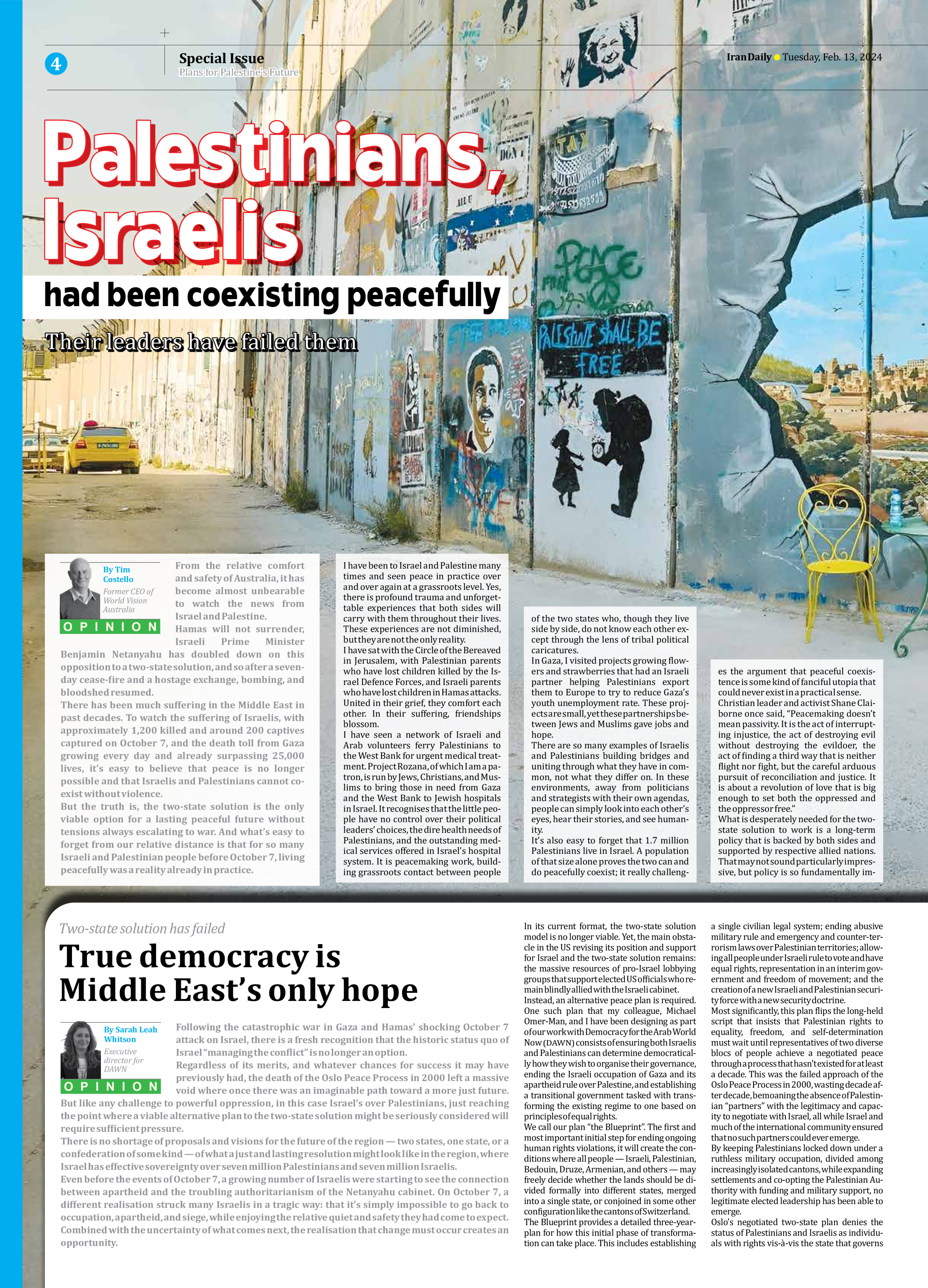
Palestinians, Israelis
had been coexisting peacefully
Their leaders have failed them
By Tim Costello
Former CEO of World Vision Australia
From the relative comfort and safety of Australia, it has become almost unbearable to watch the news from Israel and Palestine.
Hamas will not surrender, Israeli Prime Minister Benjamin Netanyahu has doubled down on this opposition to a two-state solution, and so after a seven-day cease-fire and a hostage exchange, bombing, and bloodshed resumed.
There has been much suffering in the Middle East in past decades. To watch the suffering of Israelis, with approximately 1,200 killed and around 200 captives captured on October 7, and the death toll from Gaza growing every day and already surpassing 25,000 lives, it’s easy to believe that peace is no longer possible and that Israelis and Palestinians cannot co-exist without violence.
But the truth is, the two-state solution is the only viable option for a lasting peaceful future without tensions always escalating to war. And what’s easy to forget from our relative distance is that for so many Israeli and Palestinian people before October 7, living peacefully was a reality already in practice.
I have been to Israel and Palestine many times and seen peace in practice over and over again at a grassroots level. Yes, there is profound trauma and unforgettable experiences that both sides will carry with them throughout their lives. These experiences are not diminished, but they are not the only reality.
I have sat with the Circle of the Bereaved in Jerusalem, with Palestinian parents who have lost children killed by the Israel Defence Forces, and Israeli parents who have lost children in Hamas attacks. United in their grief, they comfort each other. In their suffering, friendships blossom.
I have seen a network of Israeli and Arab volunteers ferry Palestinians to the West Bank for urgent medical treatment. Project Rozana, of which I am a patron, is run by Jews, Christians, and Muslims to bring those in need from Gaza and the West Bank to Jewish hospitals in Israel. It recognises that the little people have no control over their political leaders’ choices, the dire health needs of Palestinians, and the outstanding medical services offered in Israel’s hospital system. It is peacemaking work, building grassroots contact between people of the two states who, though they live side by side, do not know each other except through the lens of tribal political caricatures.
In Gaza, I visited projects growing flowers and strawberries that had an Israeli partner helping Palestinians export them to Europe to try to reduce Gaza’s youth unemployment rate. These projects are small, yet these partnerships between Jews and Muslims gave jobs and hope.
There are so many examples of Israelis and Palestinians building bridges and uniting through what they have in common, not what they differ on. In these environments, away from politicians and strategists with their own agendas, people can simply look into each other’s eyes, hear their stories, and see humanity.
It’s also easy to forget that 1.7 million Palestinians live in Israel. A population of that size alone proves the two can and do peacefully coexist; it really challenges the argument that peaceful coexistence is some kind of fanciful utopia that could never exist in a practical sense.
Christian leader and activist Shane Claiborne once said, “Peacemaking doesn’t mean passivity. It is the act of interrupting injustice, the act of destroying evil without destroying the evildoer, the act of finding a third way that is neither flight nor fight, but the careful arduous pursuit of reconciliation and justice. It is about a revolution of love that is big enough to set both the oppressed and the oppressor free.”
What is desperately needed for the two-state solution to work is a long-term policy that is backed by both sides and supported by respective allied nations. That may not sound particularly impressive, but policy is so fundamentally important because it is the basis from which those small and everyday social changes grow, and these are the building blocks of long-term and lasting peace.
In this respect, leaders from both sides have failed. There’s been a long and concentrated effort from those in power to create a picture of “the enemy”. But when you step back from the top and look at things on a day-to-day level, we see that is not true and that peace is achievable.
At the height of apartheid in South Africa, many — myself included — believed it could only end in bloodshed; there was so much hatred. And yet, Nelson Mandela was able to show the world what the right leadership at the right time could do for the long walk to peace.
From this war, there will be a generation of Israelis and Palestinians who are deeply traumatised and shaped by what they have seen and experienced. And while projects and initiatives that support peace can act as a template for these people, they will only work with the right leadership.
It is sad to think that the one thing Hamas and the Israeli extreme right seem to agree on is undermining the two-state solution. A one-state constitution where Israelis, Arabs, and Palestinians are not equal would never be accepted, and it would be seen as an apartheid state.
I have seen Palestinians and Israelis rise above tribalism and become peacemakers. Now, those in charge must do the same.
Indeed, as Jesus said, “Blessed are the peacemakers”.
The article first appeared on the Brisbane Times.







